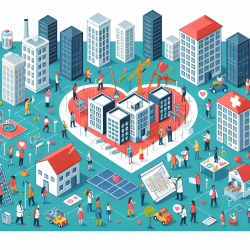Introduction
In a world where urban landscapes are constantly evolving, the implications of gentrification on health equity remain a critical area of study. The research article "Breaking Down and Building Up: Gentrification, Its Drivers, and Urban Health Inequality" provides an insightful exploration into how different types of gentrification affect health outcomes, particularly among underprivileged communities. As practitioners, understanding these dynamics can enhance our ability to support diverse populations and advocate for equitable health policies.
Understanding Gentrification and Health Inequality
Gentrification, a process marked by the influx of more affluent residents into historically under-resourced neighborhoods, often leads to significant changes in the demographic, economic, and cultural fabric of these areas. While some argue that gentrification can reduce inequalities by improving access to amenities and services, the reality is often more complex. Research indicates that gentrification can exacerbate health disparities, particularly for long-term residents who may face displacement or social exclusion.
Key Findings from the Research
- Retail Gentrification: Changes in the retail landscape can influence health by altering access to healthy foods and social spaces. Practitioners should advocate for inclusive retail policies that ensure all community members benefit from new developments.
- Environmental Gentrification: While green spaces are beneficial, their development can lead to displacement. Practitioners can work with policymakers to create equitable access to these spaces.
- Climate Gentrification: Climate-resilient infrastructure can lead to increased property values and displacement. Understanding these dynamics can help practitioners advocate for policies that protect vulnerable populations.
- Tourism Gentrification: The rise of tourism can lead to increased housing costs and social disruption. Practitioners should engage in community planning to mitigate these effects.
- Studentification and Health Care Gentrification: These processes can lead to demographic shifts and inequitable access to services. Practitioners should collaborate with educational and healthcare institutions to ensure community needs are met.
Implications for Practitioners
Practitioners can play a pivotal role in addressing the health impacts of gentrification by:
- Advocating for policies that promote equitable development and prevent displacement.
- Collaborating with community organizations to ensure that new developments meet the needs of all residents.
- Engaging in research to further understand the nuanced impacts of gentrification on health.
- Educating stakeholders about the importance of inclusive urban planning.
Conclusion
The research on gentrification and urban health inequality provides valuable insights for practitioners aiming to foster health equity. By understanding the specific drivers of gentrification and their health implications, practitioners can better advocate for policies that protect vulnerable populations and promote inclusive urban development.
To read the original research paper, please follow this link: Breaking Down and Building Up: Gentrification, Its drivers, and Urban Health Inequality.










